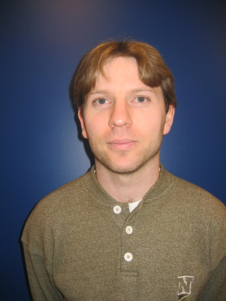Multivalent self-assembly at interfaces: from fundamental kinetic aspects to applications in nanofabrication
Promotion date: 8 January 2009
Thesis advisors: Prof. Dr. Jurriaan Huskes and Prof. Dr. David N. Reinhoudt
| The focus in this thesis is on multivalent molecular self-assembly, on solid surfaces, studied both for fundamental reasons and technological applications. Heavyweight dendritic molecules with thioether end-groups are employed as low diffusive inks, to faithfully transfer sub-micrometer features onto gold via positive μCP (microcontact printing). Control over inking and transfer of specific molecules is obtained by receptor-functionalized stamps performing supramolecular microcontact printing. The multivalent binding at interfaces is discussed from a kinetic and thermodynamic point of view. Mono-, di- and trivalent fluorescent guest molecules are microcontact printed on a molecular printboard, and the kinetic stability of the patterned self-assembled monolayers is studied by means of fluorescence microscopy. The results presented in this thesis, reveal the complexity and some important governing principles of multivalent molecular interactions on surfaces. |
What was an important moment during your master thesis project?
It was more like a uniform development. Right in the beginning I was able to build nice golden patterns. So, that was a good start that proofed to be psychologically important. My thesis consists of several chapters that differ one from the other. They are connected with some keywords like: molecular spreading on a solid surface, and multivalent supramolecular host-guest interactions.
The actual work involved a lot of steps: studying theory, constructing experimental set-ups, gaining results and images, new calculations et cetera. Although several things went inevitably wrong, I gained nice results during the whole period.
Is there one result in particular that appeals to you?
I was able to find a way to detect and quantify spreading of multivalent molecules on a molecular printboard, which is: a monolayer of host molecules. Multivalent guest molecules bind reversibly to the molecular printboard, so when these samples are immersed in a solution containing free hosts, the competition between the surface-linked and the free hosts in the solution induces a series of events, resulting in surface spreading of the fluorescent pattern.
How did you come into contact with MESA+?
I did a one year master at the University of Twente that collaborated with Babes-Bolyai University in Cluj, Romania. Then I applied for this thesis project. Working in the clean-room and using all the equipments was very good, and the people were friendly and always helping me out. It made work look like a hobby to me.
In my opinion MESA+ must continue to keep a continuous flow of internationally recognized publications. The institute has the possibilities and power to find new topics for that, time and time again. It also has the ability to adjust itself, if government policies alter or society asks new kinds of output.
What are your future plans?
I started a job at Zutphen, for two years, at the company Nanosens, specialized in membranes and nanowires. My job is to functionalize these nanowires to use them as (bio)sensors. It is a good job for me, because I like doing research and now I have the chance to see what company-research is like.
After this, I can still decide which way to go: academic research or more application-minded research. There is no need this will be in the Netherlands, but I would like to settle somewhere in Europe in the future.

